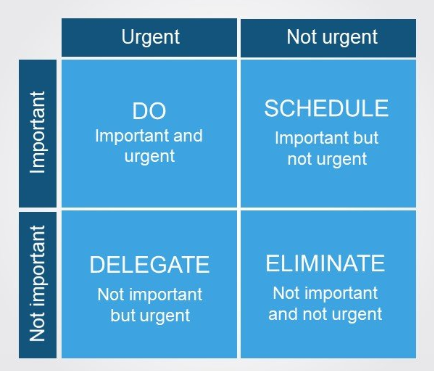
Great time management involves being efficient and effective. However, determining what’s important vs. what’s urgent is what can make time management so difficult. We often fall in the trap of believing all urgent tasks are also important, even if that’s seldom the case. In fact, most of the things trying to steal our attention are usually inconsequential, non-important tasks, with a high sense of urgency.
Solution: The Eisenhower Principle
The Eisenhower Principle originates from a quote attributed to the former U.S. President, Dwight D. Eisenhower:
“I have two kinds of problems, the urgent and the important. The urgent are not important, and the important are never urgent.”
The principle itself is pretty simple – evaluate your task in terms of urgency and importance, and then place them in different quadrants of the Eisenhower Matrix. This will give you a visual overview of how to prioritize your tasks.
Urgent vs. Important Tasks
Let’s start by defining what constitutes an urgent task versus an important task.
URGENT
A task defined as urgent requires immediate action or attention.
Examples:
- Crises
- Pressing problems
- Projects with deadlines
- Interruptions (calls, meetings, emails)
IMPORTANT
A task defined as important often relates to long-term goals.
Examples:
- Planning, research, design, testing
- Capability improvements
- Relationship building
- Developing change, direction, and strategy
Quadrants
The Eisenhower Matrix consists of four different quadrants, based on urgency and importance. The quadrants are as follows:

1 – Urgent and Important: DO FIRST
– If a task is both urgent and important, do it right away.
2 – Not Urgent but Important: SCHEDULE
– If a task is important, but not urgent, set a due date and do it later.
3 – Urgent but not Important: DELEGATE
– If a task is urgent, but not important, the best thing is to delegate it to someone else.
4 – Not Urgent and not Important: DON’T DO
– If a task is neither important nor urgent, it should not be prioritized. Drop it or do it when you have some extra time.
What you need to tackle first are the tasks that are BOTH urgent and important. On the opposite spectrum, the tasks that are neither urgent nor important should be your last priority. However, it can be difficult to decide what to focus on when it comes to tasks that are “not urgent and important” or “urgent and not important”. This is where it’s crucial to remember that if you focus all of your time on urgent tasks, the important tasks will never get done. Urgent does not equal important.
Implementing the Eisenhower Matrix
Using the Eisenhower Matrix will enable you to get a better picture of how to prioritize your tasks to build an efficient and effective schedule. Remember, start by doing what’s important, ranked by urgency. If you have the capacity do to some of the non-important tasks, do them after you finished all important tasks – or delegate/drop them depending on urgency. By following this simple framework, you can eliminate time-wasters in your life and create more mental space to make progress on your goals.

 The Most Important Factor For Your Business
The Most Important Factor For Your Business